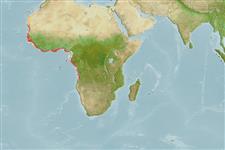Common names from other countries
Environment: milieu / climate zone / depth range / distribution range
বাস্তুসংস্থান
; গভীরতার পরিসীমা 17 - 160 m (Ref. 275), usually 70 - 140 m (Ref. 275). Tropical; 28°N - 13°S, 21°W - 14°E (Ref. 1695)
Eastern Atlantic: from Canary Island and Guinea Current to Angola.
Length at first maturity / আকৃতি / ওজন / Age
Maturity: Lm ? range ? - ? cm Max length : 18.0 cm ML পুরুষ/ লিঙ্গ অনিধর্ারিত ; (Ref. 1695); 13.4 cm ML (female)
Maximum size for male/unsexed is 18 cm, mantle length (Ref. 104052). Minimum depth from Ref. 91331. Feeds on molluscs (including other cephalopods), crustaceans and small fishes (Ref. 275).
Life cycle and mating behavior
পরিপক্কতা | প্রজনন | ডিম ছাড়া | ডিমসমূহ | ডিম্বধারন ক্ষমতা | শুককীট
Members of the class Cephalopoda are gonochoric. Male and female adults usually die shortly after spawning and brooding, respectively. Mating behavior: Males perform various displays to attract potential females for copulation. During copulation, male grasp the female and inserts the hectocotylus into the female's mantle cavity where fertilization usually occurs. Life cycle: Embryos hatch into planktonic stage and live for some time before they grow larger and take up a benthic existence as adults.
Jereb, P. and C.F.E. Roper (eds.). 2005. (Ref. 1695)
IUCN Red List Status (Ref. 130435)
CITES status (Ref. 108899)
Not Evaluated
Not Evaluated
Human uses
মৎস্য: বাণিজ্যিক
| FIRMS (Stock assessments) | FishSource |
হাতিয়ার
আরো তথ্য
Age/Sizeবৃদ্ধিLength-weightLength-lengthবহিঃ অঙ্গ সংস্থানশুককীট প্রাচুর্য
ইন্টারনেট সুত্র
Estimates based on models
Preferred temperature
(Ref.
115969): 15.1 - 17.3, mean 16.3 (based on 26 cells).
Vulnerability
Low vulnerability (10 of 100).
